Measuring the Frictional Behavior and Adhesion of PET Bottles
Abstract
:1. Introduction
2. Materials and Methods
3. Results and Discussion
4. Conclusions
- Higher average friction and higher spread of values were observed when no lubrication was applied. However, the root cause of the fluctuation is completely different between the clear and opaque white PET: in the first case it is due to sticking phenomena and in the second case to surface topographical features (asperities). This can be confirmed by the 3D friction patterns (triboscopy), where the clear PET shows high localized sticking phenomena at the start of the motion, whereas the opaque white PET shows a more homogenous friction throughout the whole cycle.
- Adhesive forces can be seen in the case of clear PET bottles without lubrication, in the retraction part of the identification-retraction curves. When applying a thin lubricant layer on the clear PET or when changing the PET structure from clear to opaque white, no adhesion forces were measured.
- With this new two-step test approach, both the localized sticking phenomena and the adhesion due to electrification (caused by friction) can be evaluated easily. This will help in minimizing the risk of bottle pileups during transferring and can improve production efficiency.
Author Contributions
Funding
Institutional Review Board Statement
Informed Consent Statement
Data Availability Statement
Acknowledgments
Conflicts of Interest
References
- Welle, F. Twenty years of PET bottle to bottle recycling—An overview. Resour. Conserv. Recycl. 2011, 55, 865–875. [Google Scholar] [CrossRef]
- Plastics—The Facts 2021, European Plastics Producers Association Annual Report; Plastics Europe: Bruxelles, Belgium, 2021.
- Brandau, O. Bottles, Preforms and Closures: A Design for PET Packaging, 2nd ed.; Plastic Design Library; Elsevier: Amsterdam, The Netherlands, 2012. [Google Scholar]
- Zhang, J.; Darwish, N.; Coote, M.L.; Ciampi, S. Static Electrification of Plastics under Friction: The Position of Engineering-Grade Polyethylene Terephthalate in the Triboelectric Series. Adv. Eng. Mater. 2020, 22, 1901201. [Google Scholar] [CrossRef]
- ASTM D1894-14; Standard Test Method for Static and Kinetic Coefficients of Friction of Plastic Film and Sheeting. ASTM International: West Conshohocken, PA, USA, 2016.
- Sukumaran, J.; De Pauw, J.; Neis, P.D.; Tóth, L.F.; De Baets, P. Revisiting polymer tribology for heavy duty application. Wear 2017, 376–377, 1321–1332. [Google Scholar] [CrossRef]
- Sierros, K.A.; Kukureka, S.N. Tribological investigation of thin polyester substrates for displays. Wear 2007, 263, 992–999. [Google Scholar] [CrossRef]
- Jozwik, J.; Dziedzic, K.; Barszcz, M.; Pashechko, M. Analysis and comparative assessment of basic tribological properties of selected polymer composites. Materials 2020, 13, 75. [Google Scholar] [CrossRef] [PubMed]
- Tóth, L.F.; Sukumaran, J.; Szebényi, G.; De Baets, P. Tribo-mechanical interpretation for advanced thermoplastics and the effects of wearinduced crystallization. Wear 2019, 440–441, 203083. [Google Scholar] [CrossRef]
- Filippova, E.O.; Filippov, A.V.; Shulepov, I.A. Experimental study of sliding friction for PET track membranes. IOP Conf. Ser. Mater. Sci. Eng. 2016, 125, 012020. [Google Scholar] [CrossRef]
- Liu, Y.; Song, S.; Timmers, H. Correlation of polymer wear-debris generation between microscratching and macroscopic wear. Tribol. Int. 2016, 93, 202–213. [Google Scholar] [CrossRef]
- Samyn, P.; Van Craenenbroeck, J.; Quintelier, J.; Schoukens, G. Friction induced conformational changes on large-scale and small-scale polyester sliding surfaces. Surf. Interface Anal. 2006, 38, 868–872. [Google Scholar] [CrossRef]
- Samyn, P.; Schoukens, G. Tribophyiscal scaling effects in friction and wear of polymers on small- and large-scale tests. Tribotest 2008, 14, 207–224. [Google Scholar] [CrossRef]
- Cho, D.-H.; Bhushan, B.; Dyess, J. Mechanisms of static and kinetic friction of polypropylene, polyethylene terephthalate, and high-density polyethylene pairs during sliding. Tribol. Int. 2016, 94, 165–175. [Google Scholar] [CrossRef]
- Cho, D.-H.; Bhushan, B. Nanofriction and nanowear of polypropylene, polyethylene terephthalate, and high-density polyethylene during sliding. Wear 2016, 352–353, 18–23. [Google Scholar] [CrossRef]
- Jia, Q.; He, W.; Hua, D.; Zhou, Q.; Du, Y.; Ren, Y.; Lu, Z.; Wang, H.; Zhou, F.; Wang, J. Effects of structure relaxation and surface oxidation on nanoscopic wear behaviors of metallic glass. Acta Mater. 2022, 232, 117934. [Google Scholar] [CrossRef]
- Belin, M.; Martin, J.M. Triboscopy, a new approach to surface degradations of thin films. Wear 1992, 156, 151–160. [Google Scholar] [CrossRef]
- Georgiou, E.P.; Drees, D.; De Bilde, M.; Anderson, M.; Carlstedt, M.; Mollenhauer, O. Quantification of Tackiness of a Grease: The Road to a Method. Lubricants 2021, 9, 32. [Google Scholar] [CrossRef]
- Rymuza, Z.; Pytko, S. The Effect of Scale in Tribological Testing. J. Mater. Res. Technol. 2012, 1, 13–20. [Google Scholar] [CrossRef]
- Achanta, S.; Celis, J.-P. On the scale dependence of coefficient of friction in unlubricated sliding contacts. Wear 2010, 269, 435–442. [Google Scholar] [CrossRef]
- Achanta, S.; Liskiewicz, T.; Drees, D.; Celis, J.-P. Friction mechanisms at the micro-scale. Tribol. Int. 2009, 42, 1792–1799. [Google Scholar] [CrossRef]
- Drees, D.; Celis, J.-P.; Achanta, S. Friction of thin coatings on three length scales under reciprocating sliding. Surf. Coat. Technol. 2004, 188–189, 511–518. [Google Scholar] [CrossRef]
- Achanta, S.; Drees, D.; Celis, J.-P. Investigation of Friction in the Meso Normal Force Range on DLC and TiN Coatings. J. ASTM Int. 2007, 4, 1–12. [Google Scholar] [CrossRef]
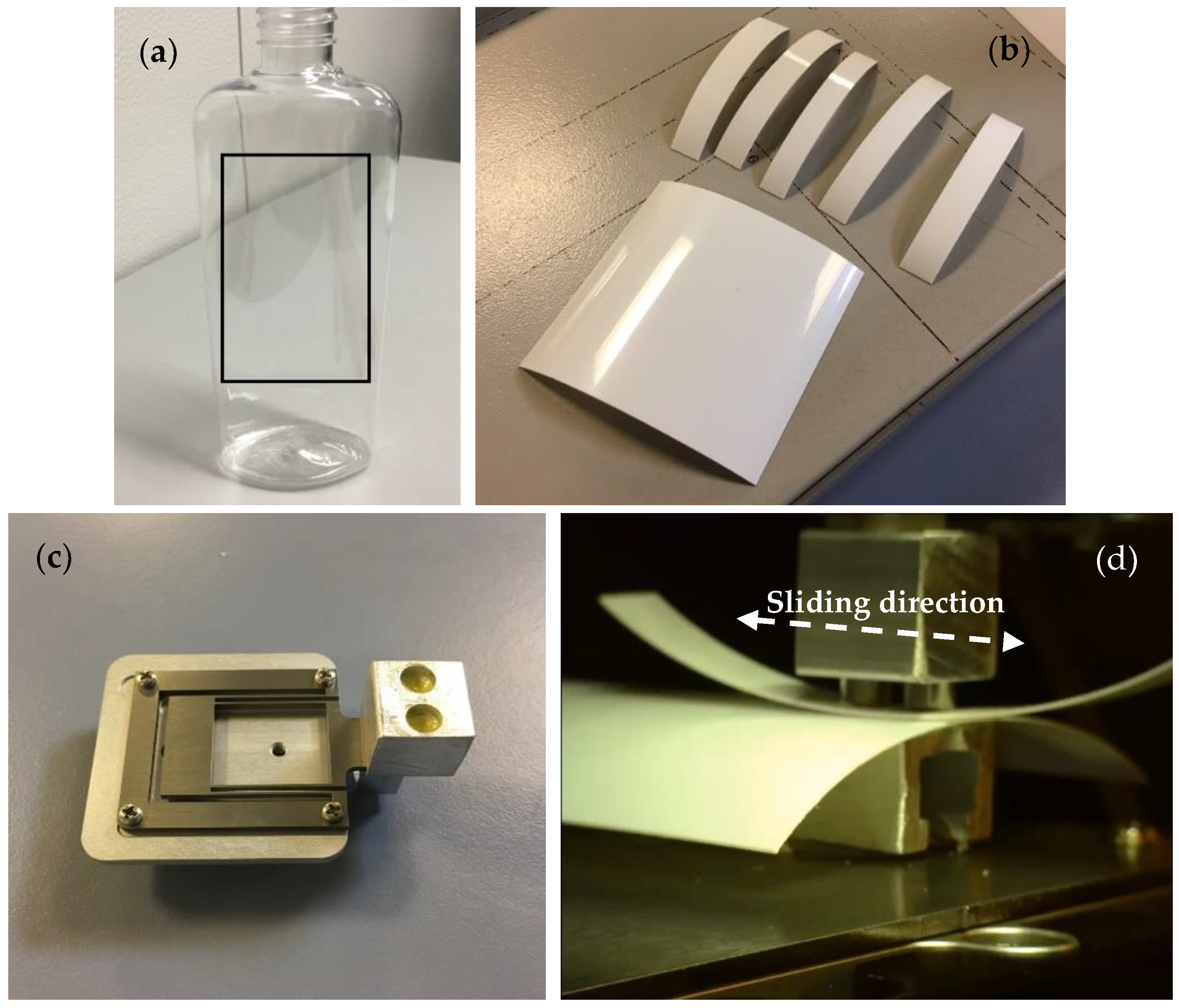
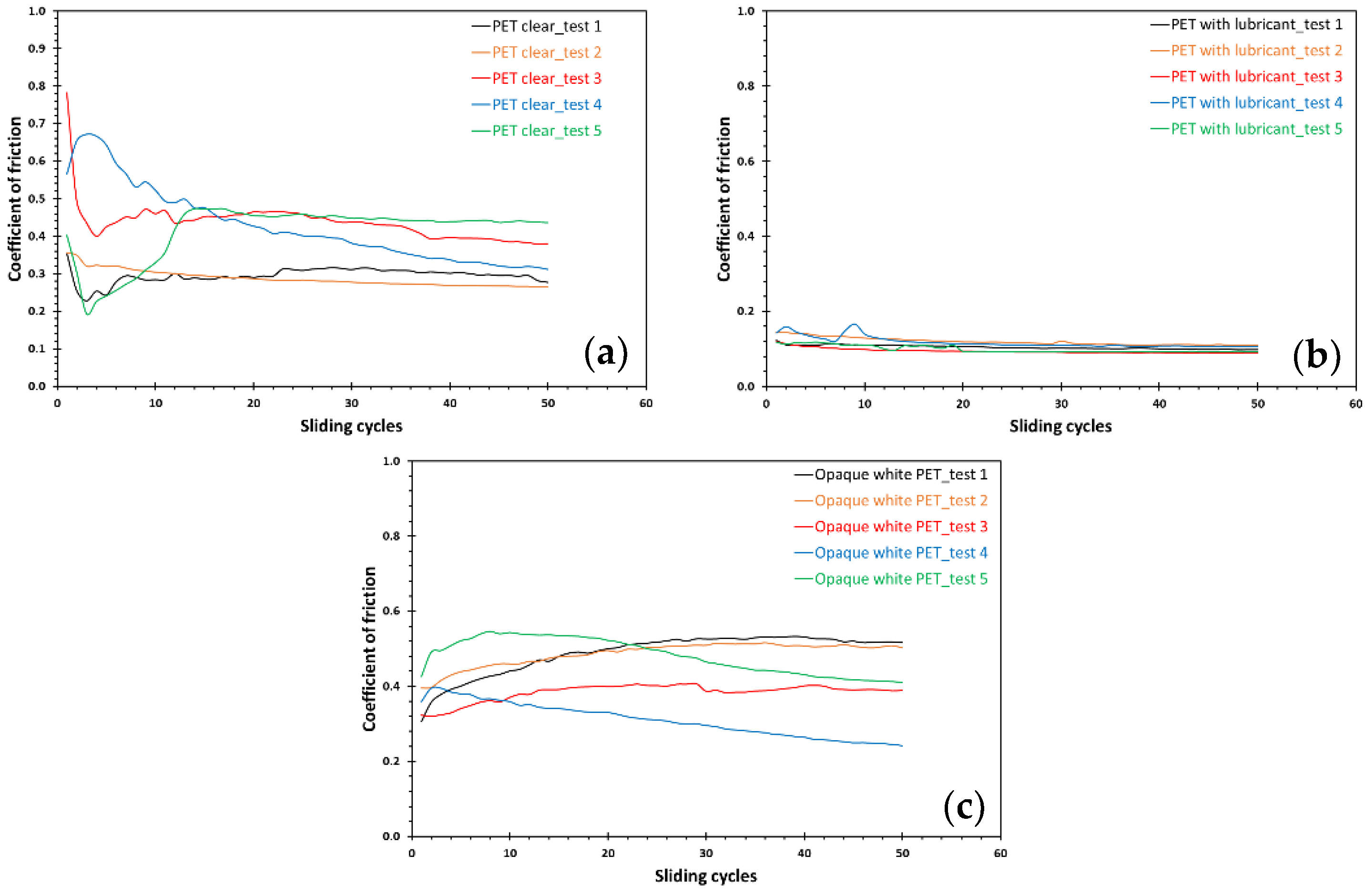
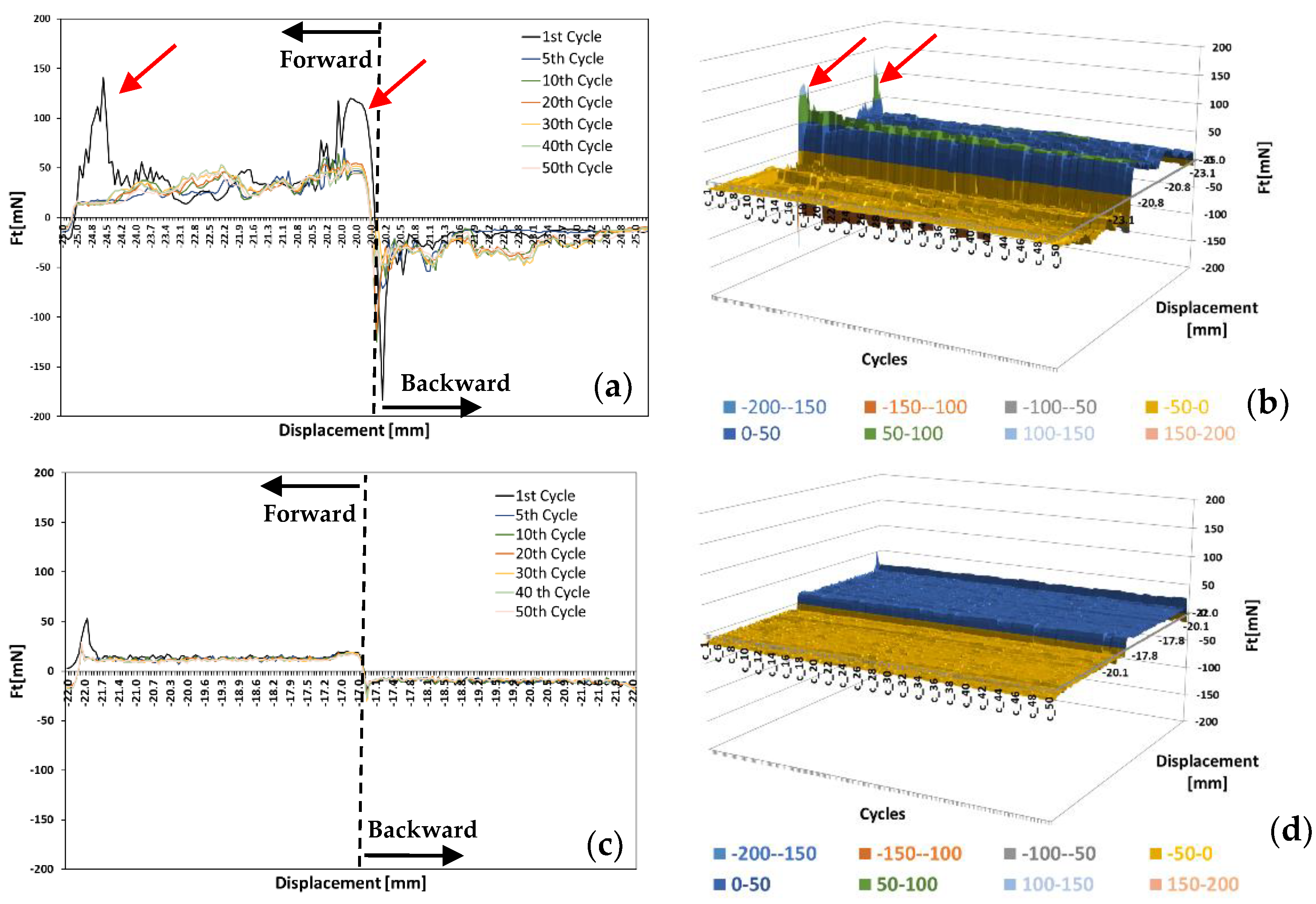
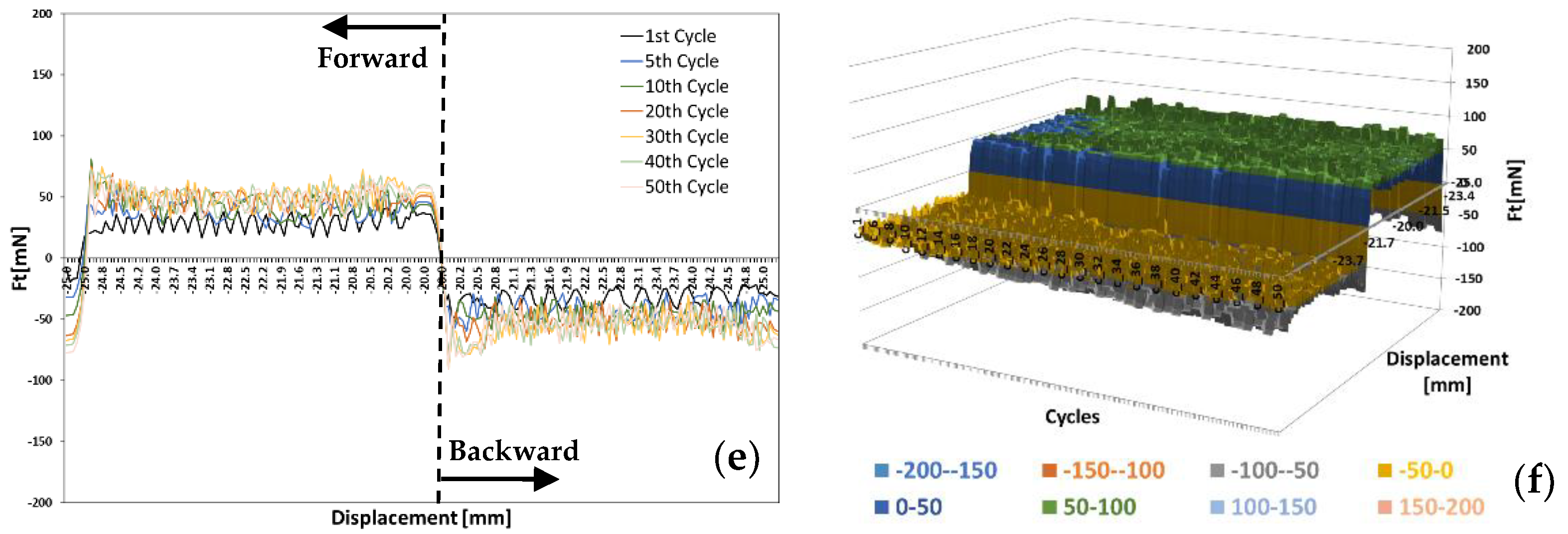

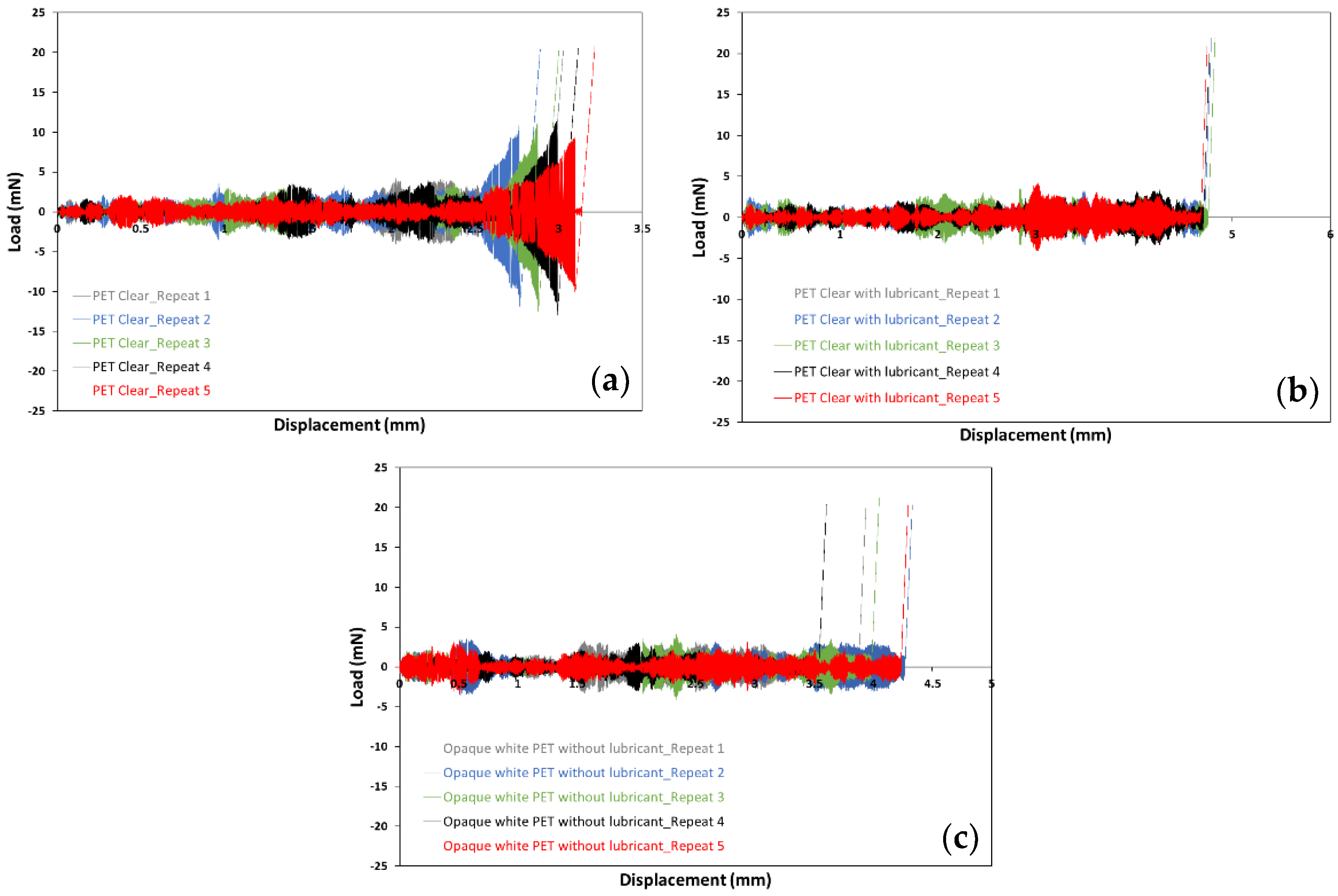
| Contact Geometry: | Crossed Cylinder |
|---|---|
| Applied load (mN): | 100 |
| Nominal sliding speed (mm/s): | 1 |
| Stroke (one way) (mm): | 5 |
| Acceleration time (s): | 0.1 |
| Number of cycles: | 50 |
| Contact Geometry: | Crossed Cylinder |
|---|---|
| Applied load (mN): | 20 |
| Approach speed (mm/s): | 0.01 |
| Retraction speed (mm/s): | 0.1 |
| Retraction distance (mm): | 2 |
Publisher’s Note: MDPI stays neutral with regard to jurisdictional claims in published maps and institutional affiliations. |
© 2022 by the authors. Licensee MDPI, Basel, Switzerland. This article is an open access article distributed under the terms and conditions of the Creative Commons Attribution (CC BY) license (https://creativecommons.org/licenses/by/4.0/).
Share and Cite
Georgiou, E.P.; Drees, D.; Lopes, L.M.; Gerlach, C. Measuring the Frictional Behavior and Adhesion of PET Bottles. Lubricants 2022, 10, 204. https://doi.org/10.3390/lubricants10090204
Georgiou EP, Drees D, Lopes LM, Gerlach C. Measuring the Frictional Behavior and Adhesion of PET Bottles. Lubricants. 2022; 10(9):204. https://doi.org/10.3390/lubricants10090204
Chicago/Turabian StyleGeorgiou, Emmanuel P., Dirk Drees, Lais M. Lopes, and Christian Gerlach. 2022. "Measuring the Frictional Behavior and Adhesion of PET Bottles" Lubricants 10, no. 9: 204. https://doi.org/10.3390/lubricants10090204





